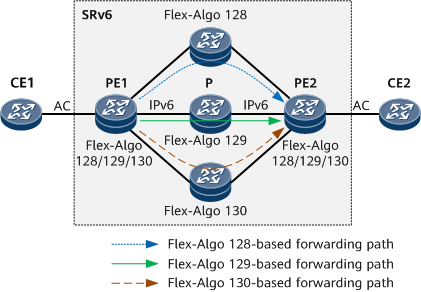Configuring EVPN VPWS over SRv6 Flex-Algo
This section describes how to configure EVPN VPWS over SRv6 Flex-Algo.
Context
EVPN VPWS uses the EVPN E-Line model to carry P2P VPWS services.
EVPN VPWS over SRv6 Flex-Algo uses forwarding paths calculated based on Flex-Algos to carry VPWS services on the public network.
On the network shown in Figure 1, multiple links exist between PEs. You can configure the PEs to forward VPWS services over a path calculated using a specified Flex-Algo.
Pre-configuration Tasks
Before performing the configuration, complete the following tasks:
Configure IS-IS to enable devices to communicate at the network layer.
- Enable the advertisement of IPv6 delay information if the Flex-Algo metric type is delay.
Procedure
- Configure Flex-Algo link attributes.
- Configure a FAD.
- Configure IPv6 IS-IS on each PE and P. For details, see Configuring Basic IPv6 IS-IS Functions.
- Configure EVPN and EVPL instances on each PE.
- Configure an AC interface.
- Establish a BGP EVPN peer relationship between PEs.
- Configure basic SRv6 functions.
- Enable IS-IS SRv6 on the PEs and Ps, and configure IS-IS Flex-Algo.
- Configure EVPN routes on PEs to carry SIDs and recurse to SRv6 BE paths based on the SIDs.
Verifying the Configuration
After configuring EVPN VPWS over SRv6 Flex-Algo, verify the configuration.
Run the display bgp evpn evpl command to check all EVPL instance information.
Run the display bgp evpn { all | route-distinguisher route-distinguisher | vpn-instance vpn-instance-name } routing-table [ { ad-route | es-route | inclusive-route | mac-route | prefix-route } prefix ] command to check BGP EVPN route information.
Run the display segment-routing ipv6 local-sid end-dx2 evpl-instance evpl-id forwarding command to check information about the SRv6 BE local SID table.
- Run the display isis process-id flex-algo [ flex-algo-id ] [ level-1 | level-2 ] command to check the preferred FAD in the LSDB.
- Run the display isis lsdb [ { level-1 | level-2 } | verbose | { local | lsp-id | is-name symbolic-name } ] * [ process-id | vpn-instance vpn-instance-name ] command to check IS-IS LSDB information.
- Run the display isis process-id route ipv6 flex-algo [ flex-algo-id ] [ verbose | [ level-1 | level-2 ] | ipv6-address [ prefix-length ] ] * or display isis route [ process-id ] ipv6 flex-algo [ flex-algo-id ] [ verbose | [ level-1 | level-2 ] | ipv6-address [ prefix-length ] ] * command to check Flex-Algo-related IS-IS route information.
- Run the display isis [ process-id ] spf-tree [ systemidsystemid ] ipv6 flex-algo [ flex-algo-id ] [ [ level-1 | level-2 ] | verbose ] * command to check the SPF tree topology information of a specified Flex-Algo.

